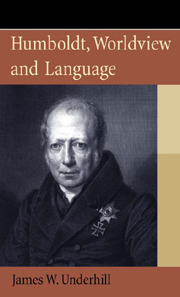Book contents
- Frontmatter
- Contents
- Acknowledgements
- Preface
- Part I Language and World
- Part II Humboldt, Man and Language
- 7 Worldview (Weltanschauung or Weltansicht)
- 8 Sprache
- 9 The Work of the Mind
- 10 Form
- 11 Creativity, Culture and Character
- 12 Catching the Character
- 13 A Seeing and Feeling Worldview
- 14 Four Dangers in the Comparative Approach
- 15 Reformulating the Worldview Hypothesis World
- 16 A Final Word
- Glossary
- Bibliography
- Index
13 - A Seeing and Feeling Worldview
from Part II - Humboldt, Man and Language
Published online by Cambridge University Press: 12 September 2012
- Frontmatter
- Contents
- Acknowledgements
- Preface
- Part I Language and World
- Part II Humboldt, Man and Language
- 7 Worldview (Weltanschauung or Weltansicht)
- 8 Sprache
- 9 The Work of the Mind
- 10 Form
- 11 Creativity, Culture and Character
- 12 Catching the Character
- 13 A Seeing and Feeling Worldview
- 14 Four Dangers in the Comparative Approach
- 15 Reformulating the Worldview Hypothesis World
- 16 A Final Word
- Glossary
- Bibliography
- Index
Summary
As we saw in the last chapter, we are faced then with two equally unsatisfactory extremes when it comes to comparing languages. On the one hand, the fragment can obscure the whole: taking Plato's Greek to be a representative fragment of the Greek worldview can mislead us. On the other hand, the failure to focus on the parts of the whole (i.e. individual discourse) can lead us into a formal understanding which is not merely superficial but indeed blind to the actual nature of language as the means by which individuals express meaning.
The comparison of worldviews, if that is to become our project, is also hampered by the very term worldview. The term, as we have seen, has two clearly separate meanings. As Weltansicht, it is the patterning of conceptual frameworks and the organisation of ideas which makes up the form of the language (in Humboldt's definition of form), the patterning within which we think and without which we cannot think in any conceptual or sophisticated manner. In Weltanschauung, it is the intellectual refinement and elaboration of those fundamental conceptual frameworks which enable us to give form to various mindsets or ideologies. The first notion of worldview (Weltansicht) implies the socially constructed formation of the individual's mind and his linguistic capacity. The second (Weltanschauung) implies the construction of various kinds of world-conceptions which takes place in our speech with others.
- Type
- Chapter
- Information
- Humboldt Worldview and Language , pp. 106 - 112Publisher: Edinburgh University PressPrint publication year: 2009



